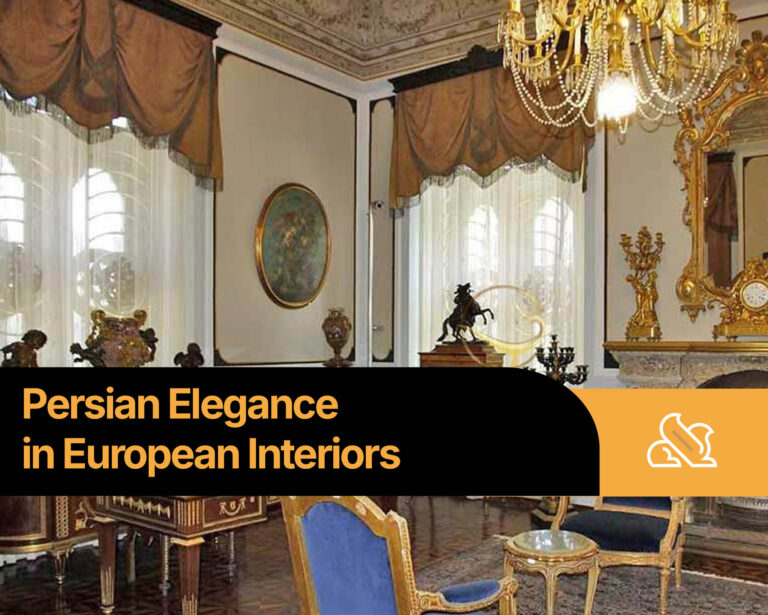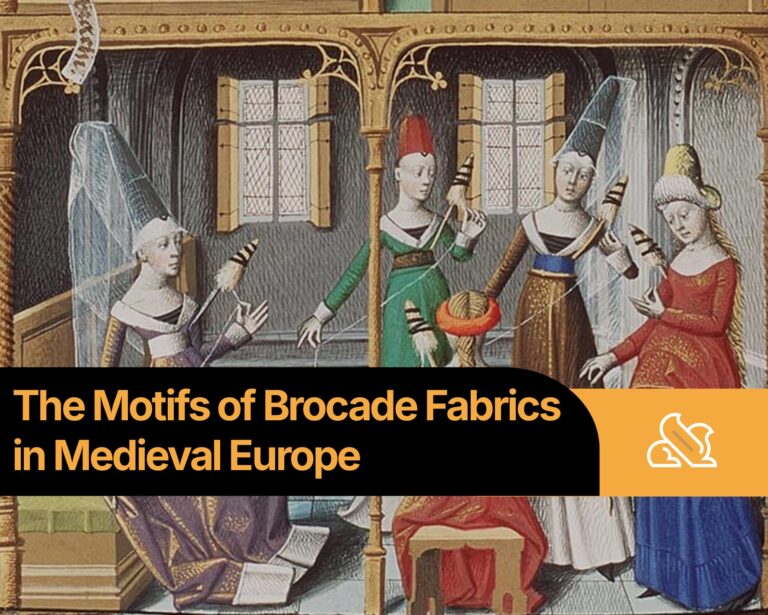If you are familiar with the history of medieval art, you know that brocade (a richly decorative shuttle-woven fabric) was one of the most luxurious and symbolic textiles of that era in Europe. The use of brocade during the Middle Ages extended beyond garments; it was integrated into illuminated manuscripts, paintings, sculptures, stained glass windows, and more. With its elaborate motifs and rich textures, brocade held a prominent place in both ecclesiastical and aristocratic settings. It symbolized wealth, status, and religious devotion, while also reflecting the values and artistic influences of different European societies. This article explores the motifs and patterns of brocade textiles across various European regions during the Middle Ages, with a focus on their cultural and religious connotations.
Origins of Brocade in Europe and Eastern Influence
The arrival of brocade in Europe was largely facilitated by trade routes such as the Silk Road, with textiles arriving from China and Persia. Merchants, diplomats, and travelers from the Middle East and Asia brought these exquisite fabrics to Europe. Among the earliest producers in Europe was the Byzantine Empire, which developed a distinctive style of brocade featuring both religious and imperial iconography that significantly influenced neighboring regions.
Byzantium and Religious Iconography: In Byzantine brocades, motifs were deeply tied to Christian symbolism, including large crosses, saints, and scenes from the Bible. These fabrics were often used in churches and sent as diplomatic gifts, reinforcing both political alliances and religious unity.
Brocade in Italy: Artistic Flourish and Religious Influence
Italy—especially cities like Florence and Venice—emerged as major centers of brocade production during the Middle Ages. Italian brocades often featured floral designs and animal motifs, influenced by both Byzantine and Islamic traditions. Over time, local interpretations infused these designs with regional identity.
Sacred and Secular Designs: Italian brocades often depicted saints, ornamental crosses, and geometric arrangements in ecclesiastical vestments. During the Renaissance, secular motifs like lions and eagles emerged, symbolizing nobility and power, frequently adorning courtly attire.
French Brocade: Cultural Identity and Royal Symbols
In France, brocade became a staple of royal and aristocratic fashion. From the 12th to 14th centuries, France was one of the major centers of textile innovation.
Floral and Heraldic Motifs: French brocades often incorporated lilies, roses, and grapevines—symbols of fertility and divine grace. Mythical creatures like griffins and dragons were also common, used to denote authority and mysticism in royal garments.
English Brocade: Eastern Inspirations and Local Themes
England adopted brocade through trade with the Byzantine Empire and Islamic regions. The English nobility used brocade for ceremonial garments and decorative furnishings.
Geometric and Interlaced Patterns: English brocades fused Eastern motifs with local traditions, such as Celtic crosses and Gothic floral forms. The combination created a distinct aesthetic that resonated with the country’s religious and feudal culture.
Spanish Brocade: A Harmonious Blend of Islam and Christianity
Due to the Muslim presence in Al-Andalus, Spain became a unique site for artistic fusion. Brocade production in Spain was heavily influenced by Islamic aesthetics.
Arabesque and Religious Fusion: Spanish brocades were adorned with intricate arabesques, calligraphy, and stylized botanical forms. After the Reconquista, Christian imagery—like the Virgin Mary and saints—was merged with these Islamic patterns, creating textiles that reflected Spain’s multicultural fabric.
Cultural and Social Significance of Brocade Motifs
Brocade was not merely a material but a visual language of power and piety. The motifs on these textiles communicated allegiance, social hierarchy, and spiritual beliefs. Religious institutions used them to glorify divine services, while courts wielded them as tools of diplomacy and prestige.
Legacy and Continuity: Brocade’s Enduring Impact
The visual codes embedded in medieval brocade continue to influence modern textile design. Contemporary weavers and fashion designers often revisit these motifs, drawing inspiration from their rich symbolism and historical roots. Museums across Europe preserve these artifacts as testimony to the artistic and cultural dialogues of the Middle Ages.
New Section: Technological Innovations in Brocade Weaving During the Middle Ages
The intricate beauty of medieval brocade was made possible by several technological advancements that emerged throughout the Middle Ages. These innovations not only enhanced the complexity and durability of fabrics but also democratized access to certain designs across broader social strata.
Loom Improvements: One of the pivotal developments was the refinement of drawlooms, which allowed weavers to create complex patterns more efficiently. Originally developed in China and brought to Europe through Islamic Spain and Byzantium, the drawloom enabled precise manipulation of individual warp threads. This advancement was particularly significant in centers like Lucca and Lyon, where weaving became a high art form.
Silk and Metallic Thread Integration: The use of silk, often imported from Asia, combined with locally produced metallic threads (usually gold or silver wrapped around a silk core), gave brocade its distinctive luster. These materials were not only aesthetic choices but also reinforced the fabric’s association with wealth and sanctity.
Guilds and Workshops: With the rise of urban guilds, the production of brocade became highly organized. Workshops employed skilled artisans who specialized in different aspects of production, from dyeing and spinning to weaving and embroidery. Guilds also regulated quality and protected design secrets, ensuring the exclusivity and desirability of brocade.
Pattern Books and Transmission of Motifs: By the late Middle Ages, pattern books began to circulate among textile artisans. These books documented popular motifs and helped standardize designs across regions. They were instrumental in maintaining a coherent visual language, even as styles evolved and diversified.
Through these innovations, brocade transformed from a rare luxury into a widespread symbol of cultural identity. Its motifs were no longer confined to the elite but began to appear in ecclesiastical vestments, civic ceremonies, and even middle-class wardrobes, albeit in simplified forms.
Conclusion
The motifs of medieval European brocade were more than ornamental—they were emblems of faith, power, and artistic exchange. Shaped by religious traditions, cultural interactions, and technological advances, these textiles reflect the intricate history of medieval Europe itself. Their enduring appeal lies not only in their visual richness but also in their ability to narrate a complex story of human creativity, devotion, and ambition.



